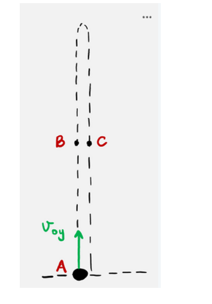A rock is thrown directly up an with an initial velocity of 32.8 m/s at instant A as shown in the figure below. As it moves up, it will reach a certain height 19.6m at insant B. It comes back to the same height during its fall from the maximum height at instant C. Determine the time it takes for the rock to go from A to C. Express your answer using one decimal place in units of seconds.
A rock is thrown directly up an with an initial velocity of 32.8 m/s at instant A as shown in the figure below. As it moves up, it will reach a certain height 19.6m at insant B. It comes back to the same height during its fall from the maximum height at instant C. Determine the time it takes for the rock to go from A to C. Express your answer using one decimal place in units of seconds.

Step by step
Solved in 3 steps with 2 images

I have reached the same two values that you have reached, but the way I solved the question was that I added the two values to find the time needed from A to C. Why did you choose not to add the two values?
Just a follow up question, did you insert them into the quadratic equation? and if so, how can we know the point connnections?

